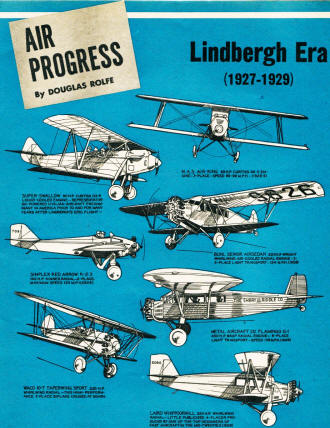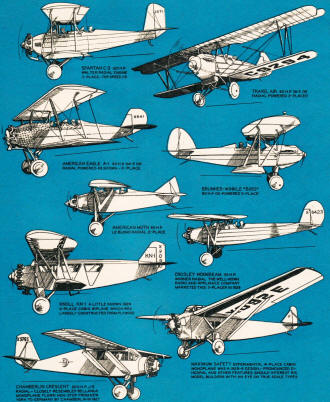|
The "Golden Age of Flight" is unofficially the period
of time between World War I and World War II; i.e., the 1920s and 1930s. The Wright Brothers
and their immediate followers had worked out the basics of flight control and engine building, and the
race was on to design airplanes for commercial passenger and freight transportation, recreational pursuits,
and military applications. Part of that process was the setting of records for closed course and long
distance speed, time to climb, altitude, and high-G maneuvers. Proving new concepts in airframe, powerplant,
and instrumentation was necessary, as was developing equipment and techniques for facilitating precision
navigation - both visual and by instrument. During the era, aviation transitioned from being a mere
curiosity for the public and barnstorming daredevil pilots to establishing a serious business that engaged
a growing percentage of the population.
Air Progress: Lindbergh Era (1927-1929)
By Douglas Rolfe
 Commercial aviation in America was a struggling and financially
perilous industry at the time of Lindbergh's New York-Paris flight, and by far the majority of civil
aircraft in operation then were either war-surplus types or conversions. The success of the "Lone Eagle's"
flight, however, served as a shot in the arm, and within a few years scores of aircraft by American
designers were being offered as "tomorrow's plane today!" Since an enormous quantity of war-surplus
Curtiss OX-5 engines were still available at low disposal prices, and since the Wright Whirlwind was
a very expensive engine, it is hardly surprising to discover that a great number of new OX-powered open
cockpit biplanes appeared. Some of these are featured on these pages, as well as some of the more involved
types which blossomed briefly. It is interesting to note that the Laird "Whippoorwill" was not the product
of the E. M. Laird Airplane Co., builders of the famous Solution and Supersolution racing airplanes
and he fast Speedwing three-place biplanes, but was a different concern called Laird Aircraft Corp.
of Wichita, Kan. E. M. Laird was the original builder of the Swallow, back in 1923, which design was
later acquired by other interests, and "Matty" Laird started manufacturing his speedsters in Chicago,
Ill. ... The planes shown here have never before appeared in Air Progress; other unpublished types of
same era will follow. Commercial aviation in America was a struggling and financially
perilous industry at the time of Lindbergh's New York-Paris flight, and by far the majority of civil
aircraft in operation then were either war-surplus types or conversions. The success of the "Lone Eagle's"
flight, however, served as a shot in the arm, and within a few years scores of aircraft by American
designers were being offered as "tomorrow's plane today!" Since an enormous quantity of war-surplus
Curtiss OX-5 engines were still available at low disposal prices, and since the Wright Whirlwind was
a very expensive engine, it is hardly surprising to discover that a great number of new OX-powered open
cockpit biplanes appeared. Some of these are featured on these pages, as well as some of the more involved
types which blossomed briefly. It is interesting to note that the Laird "Whippoorwill" was not the product
of the E. M. Laird Airplane Co., builders of the famous Solution and Supersolution racing airplanes
and he fast Speedwing three-place biplanes, but was a different concern called Laird Aircraft Corp.
of Wichita, Kan. E. M. Laird was the original builder of the Swallow, back in 1923, which design was
later acquired by other interests, and "Matty" Laird started manufacturing his speedsters in Chicago,
Ill. ... The planes shown here have never before appeared in Air Progress; other unpublished types of
same era will follow.
N.A.S. Air-King 90 H.P. Curtiss OX-5 Engine- 3 place - speed 85-99 M.P.H. - (1928-9)
Super-Swallow 90 H.P. Curtiss OX-5 liquid-cooled engine - representative 0X-powered civilian aircraft
predominant in America prior to and for many years after Lindbergh's epic flight -
 Buhl Senior Airsedan 220 H.P. Wright Whirlwind air-cooled radial
engine - 3-5-place light transport - 124 M.P.H. (1928) Buhl Senior Airsedan 220 H.P. Wright Whirlwind air-cooled radial
engine - 3-5-place light transport - 124 M.P.H. (1928)
Simplex Red Arrow K-2-3 100 H.P. Kinner radial - 2-place - maximum speed 120 M.P.H. (1928)
Metal Aircraft Co. Flamingo G1 450 H.P. Wasp radial engine - 8-place light transport - speed 135
M.P.H. (1928)
Waco 10-T Taperwing Sport 220 H.P. Whirlwind radial - This high-performance 3-place biplane cruised
at 130 M.P.H.
Laird Whippoorwill 220 H.P. Whirlwind radial - Little publicized 4-placer produced by one of the
top designers of fast aircraft in the mid-twenties (1928)
Spartan C-3 120 H.P. Walter radial engine 3-place - top speed 115
Travel Air 90 H.P. OX-5 or radial powered 3-placer
Spartan C-3 120 H.P. Walter radial engine 3-place - top speed 115
Travel Air 90 H.P. OX-5 or radial powered 3-placer
American Eagle !-1 90 H.P. OX-5 or radial powered as shown - 3-place
Brunner-Winkle "Bird" 90 H.P. OX-powered 3-place
American Moth 60 H.P. Le Blond radial 2-place
Crosley Moonbeam 110 H.P. Warner radial. The well-known radio and appliance company marketed this
3-placer in 1929
Knoll KN-1 A little known 1929 6-place cabin biplane which was largely constructed from plywood
Maximum safety experimental 4-place cabin monoplane was a 1928-9 design. - Produced dihedral and
other features should interest R/C model builders with an eye on true scale types
Chamberlin Crescent 220 H.P. J-5 radial - closely resembled Bellanca monoplane flown non-stop from
New York to Germany by Chamberlin in 1927
Douglas Rolfe Drawings
-
Post-Pusher Parade, May 1961 American Modeler
-
Air Progress: The Jet Engine, July 1951 Air Trails
-
Air Progress: The Bristol Story, November 1948 Air Trails
-
Auto
Progress: Down Memory Lane III, December 1954 Air Trails
- Auto
Progress: Memory Lane Collection No. 2, August 1954 Air Trails
-
Air Progress Famous Firsts, August 1954 Air Trails
-
Air Progress: Japanese Air Force World War II Fighters, December 1954 Air Trails
-
Air Progress: Lindbergh Era (1927-1929), July 1954 Air Trails
-
Air Progress: The Search for Speed, November 1950 Air Trails
-
Air Progress: Soviet Air Force Latter Day Types, March 1955 Air Trails
Posted March 25, 2017
|





